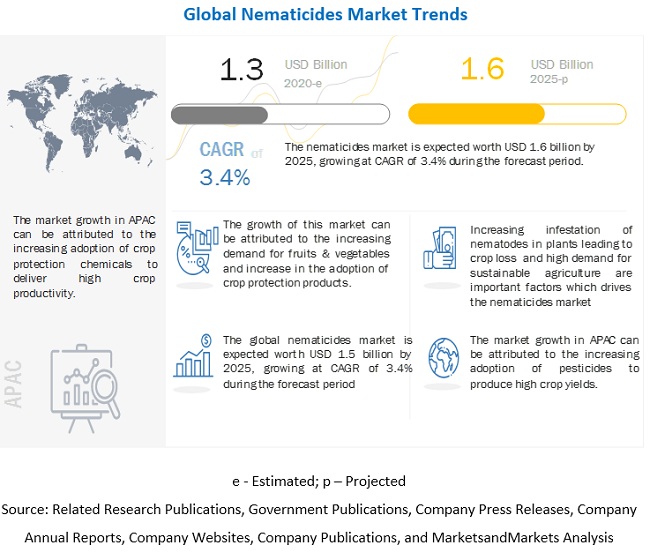The global nematicides market size is estimated to be valued at USD 1.3 billion in 2020 and is projected to be worth USD 1.6 billion by 2025, recording a CAGR of 3.4% during the forecast period. The strong demand for high-value crops, crop losses due to nematodes, and advancements in farming practices and technology are some of the factors driving growth in the nematicides market.

Constraint: Pesticide residue problems
One key restraint in the crop protection chemicals market is the pesticide residue problem due to the non-judicious use of pesticides by the farmers. Pesticide residue problems are highly found in the crops grown in developing or under-developed countries. Countries such as Vietnam, Ghana, and the Philippines are known for such low-quality crop production, affected by pesticide residues. Though intensive farming is inevitable without the use of pesticides, farmers in developing countries tend to use excess pesticides, which then damage the crops. Thus, improper use and illegal import-export of pesticides, and lack of proper government regulations have resulted in pesticide residue issues and excessive application of toxic pesticides, thereby hindering the growth of the crop protection chemicals market.
Download PDF Brochure: https://www.marketsandmarkets.com/pdfdownloadNew.asp?id=193252005
Opportunity: Providing customized solutions targeted toward specific pests
With the growing environmental and pollution concerns and health hazards from many conventional agrochemicals, the demand for natural biologicals is rising steadily across regions. Customers are witnessing a high demand for new biological products such as bionematicides to use against nematodes on standing crops, which cause crop damages, thereby reducing the overall farm yield and quality. The use of biologicals and related alternative management products is increasing. R&D teams of major global players are also engaged in discovering target-specific innovative products by using biological insecticides, which promote organic agriculture.
Fumigation and carbamates, by mode of application and type, are estimated to hold the largest shares in the nematicides industry, in terms of value, in 2020
Fumigation is a mode that is both cost-effective and efficient for tackling the problem of nematodes. In regions where there is a scarcity of water, such as South Africa, and mechanically advanced economies such as the US and Canada where the adoption of drip irrigation is feasible, the market for fumigation is set to grow. There has been an increase in the adoption of non-toxic products in soils due to the growing interest in sustainable agriculture. This has aided the growth in the use of carbamates, which are relatively less toxic than fumigants.
Vegetables, by crop type, estimated to account for the largest market share, by value, in 2020
Vegetables accounted for the largest share in the nematicides market due to the increasing acreage utilized for the cultivation of vegetables. The increased international demand for fruits & vegetables is also driving the growth of the market. The major players in the market such as BASF SE (Germany), Adama Agricultural Solutions Ltd (Israel), and Syngenta (Switzerland) are introducing nematicide solutions for crops such as tomatoes, potatoes, and peas. The increasing incidences of potato-cyst nematodes and root-knot nematodes in tomatoes have also been driving the adoption of nematicides for vegetables.
Make an Inquiry: https://www.marketsandmarkets.com/Enquiry_Before_BuyingNew.asp?id=193252005
Asia Pacific is projected to grow at the highest CAGR during the forecast period
The market for nematicides is projected to grow at the highest CAGR in the Asia Pacific region owing to the growing nematode infestation in vegetables such as tomatoes, potatoes, carrots, peas, and cauliflower in the major vegetable-growing countries such as China and India. The regulatory scenario in the Asia Pacific region is comparatively more favorable for the launch of nematicides as compared to that of Europe and North America. There is also growing awareness among farmers about the use of bionematicides since the market for organic farming, and sustainable agriculture is growing with more consumers demanding organic fruits & vegetables.
Key players in this market include Corteva Agriscience (US), Syngenta (Switzerland), Bayer AG (Germany), and BASF SE (Germany). New product launches, expansions, acquisitions, and agreements & joint ventures were some of the core strengths of the leading players in the nematicides market. These strategies were adopted by the key players to increase their market presence. It also helped them diversify their businesses geographically, strengthen their distribution networks, and enhance their product portfolios.